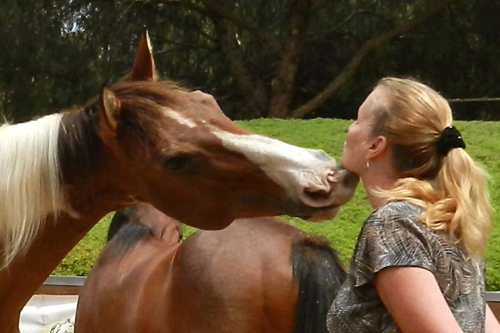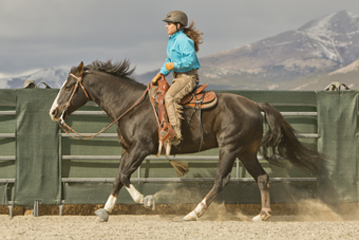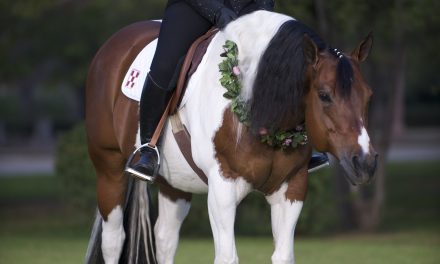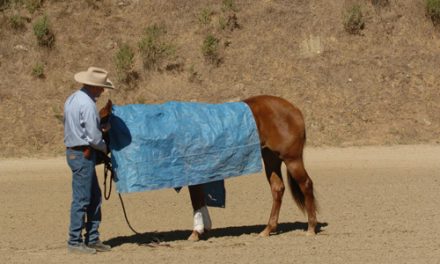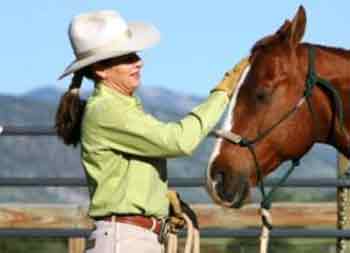How to stop a horse from doing a trick that you have trained him to do. This is a common problem.
A person can teach a horse to count and the next thing they know is that they have now created a monster because the horse paws the ground incessantly until he gets a treat.
This behavior can happen with any trick. In this blog I want to show you how to fix it. To stop this behavior takes more training. This stage, when a horse is out of control, is normal. I will explain about that later. I will show you how to move to the next stage of training so that he or she only performs a trick when asked.
Once you have a working partnership with your horse at Liberty, without the use of tack, through my Waterhole Rituals online course you may choose to teach your horse tricks to fit in with your Liberty Dancing.
I want to help you to make a smooth transition. Timing and the relationship shared between horse and trainer are so important in any kind of training. In the case of training tricks your first focus is to train the trick and then once the horse knows the trick you then shift your focus to improving the quality of your horse’s performance. At some time in the training of a trick a horse can temporarily take control of the trainer by performing the trick again right after the treat is given. This way he can get another reward and it turns into a merry-go-round of treat and trick.
A student trainer has no idea how to gain back the control of the horse’s performance. The horse is having a great time and you are treating for tricks you did not ask for. If you are at this stage I want to suggest that this situation actually has its benefits because of the enthusiasm you have built into your horse for performing tricks. Enthusiasm is never a bad thing.
This exercise I am about to share with you will help you to gain back the control of your horse and will help you to bring the trick to a flowing dance in harmony and unity. This exercise is an advanced version of the “In the Box” exercise. “In the Box” exercise was an isolated practice as you remember it from my online class. We are now taking it to the next level, asking for it in between the trick from a little different perspective.
You want the horse to see the “In the Box” exercise as another trick that he gets a reward for. When he waits like a statue he gets a treat. He learns that sometimes doing nothing gets a treat and sometimes performing gets a treat, and that certainly listening to you is most important part of his performance. When this happens you become his greatest focus. From the horse gaining this insight, his performing for tricks becomes a dance in unity and harmony with you. This is a good time to use music while training. It will give you an energy that will bring clarity to your horse in what you are asking him to do.
As soon as he gets the idea that he gets a reward for “whoa”, go back and forth between the performing trick and the trick of doing nothing, like a statue. You will begin to feel a rhythm that will help you in directing your request aids. As you go along make your horse pause a bit longer until your horse will be willing to pause between tricks as long as you need him to.
I had a horse named Navarr, he was one of my Dressage horses. He was an amazing horse and there is a picture of him in my book Naked Liberty. He is bridle-less and being ridden by my student India Gomez. I had taught him to pause for long periods of time.
I remember one time I was giving a clinic and I had put him in a pause and forgot about him. We all moved up to the barn and had lunch. When we got back Navarr was patiently standing in the same spot like a statue in the park. I felt terrible, but Navarr seemed perfectly happy to keep standing there even when we returned.
From that behavior Navarr taught me that this pause trick is a perfect way to train a horse to ground tie and to stand tied once you have trained the Uberstreichen exercises that teaches a horse to always give to a pull.
The next part of your horse’s development is not to give a treat every time for a job well done. It will help to keep a horse’s interested. As you go along you can look forward to a time that you do not need to give treats for your horse’s performance. Most horses will eventually lose interest in the treats and will just enjoy following your direction and performance, like Navarr.
This is very important to work towards this end because continued treats every time can cause your horse to become sour or lose interest in performing and need larger payments for the trick. The trick of the pause is essential for all equestrian pursuits. It helps a horse stay in touch with you and your direction. A perfect performance horse under saddle is a horse that will move forward in the speed and quality of gait that you ask for and to pause or halt when you ask.
Going forward is all about speed control and your horse staying focused on your direction and the path you ask him to take. Hope this is of help. Keep listening to the music and remember the pause and the dance. Keep breathing while feeling your whole body in rhythm with your horse. When his rhythm is off, let him feel your rhythm. It is all about relationship, experimentation, connection, freedom and ultimately being together in harmony and unity.
Have a great weekend! Be on the lookout for new horse and human sightings and may the horse be with you.
Warmly, Carolyn
_________________________________________________
2015 UPCOMING CLINICS:
Carolyn Resnick – Group Clinic in California –
May 21-24 – Beyond the Waterhole Rituals Clinic
www.carolynresnickblog.com
Teddie Ziegler – Waterhole Rituals Clinics:
June 19-21 – New Haven, MO
July 10-12 – Santa Cruz, CA
July 31 – August 2 – Manitoba, Canada
September 11-13, Bowie, MD
October 9-11, Oklahoma
www.phoenixfarms.org
Linda Salinas – Waterhole Rituals Clinics:
February 22 – March 1 – Costa Rica
April 24-26 – North Carolina
June 5-7 – New York
September 25-27 – North Carolina
www.lindajsalinas.com

